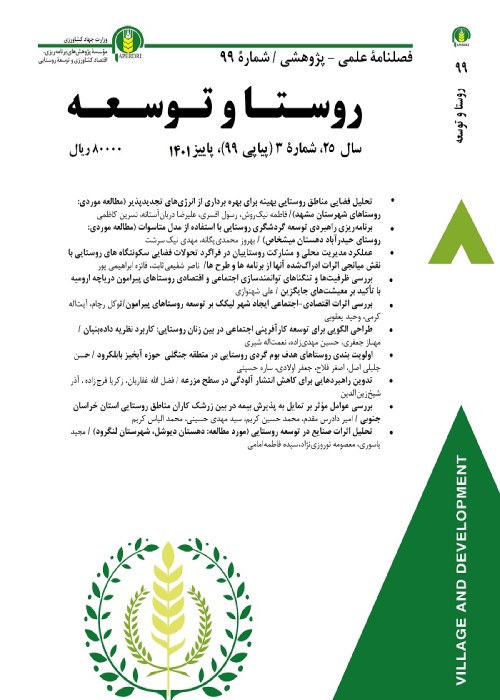Identification and Explanation of the Dimensions and Components of Rural Women's Empowerment in Lorestan Province Using Mixed Methods Research
It is very clear that in today's world, empowered women are one of the main indicators of the superiority of a society over other societies, because they will significantly increase individual performance to achieve society's goals. A developed society needs capable women so that they can create good and novel ideas and then realize them by participating in decision-makings and activities. Rural women, as hidden workers, play a vital role in home and farm activities, especially in planting, growing, harvesting, and processing livestock products. By empowering rural women, they can find appropriate solutions for problems in terms of technical, skill, interaction, etc. In other words, capable rural women can understand their duties well before they are told what to do . Empowerment strategies include equal access to opportunities, resources, credits, and education. Studies show that by empowering women, the whole society finds benefits, because empowered rural women expand the acquired capabilities in the family. They act like catalysts. By transferring the acquired abilities to others, on the one hand, the time to reach the development goals is reduced, and on the other hand, the desired goals are achieved more easily.
The present research is a sequential qualitative-quantitative mixed research with an exploratory approach. In the qualitative part, the dimensions and components of rural women's empowerment were first extracted using the meta-composite method. Due to the existence of an information gap in the data, an attempt was made to resolve this gap by using the foundation's data theory. The population of this phase of the research to conduct interview of a focus group included experts in the field of women (N=64) and a number of rural women who work in the projects of the Agriculture-Jahad Organization (N=36324). The categories extracted from the qualitative section were converted into questionnaire items, and in the quantitative section, they were validated with the help of a questionnaire survey and factor analysis. The population of the quantitative section included 80 experts from the Office of Rural Women Affairs and the service centers of Lorestan province. Due to the limited statistical population, all of them were considered as samples. In this phase, a five-item Likert scale was used to measure the importance of the measurement items. Ensuring the quality of the questionnaire, its validity and reliability were checked. The face validity of the questionnaire was checked and confirmed by providing corrective opinions of relevant experts and professors. Cronbach's alpha test was also used to check the reliability. The results showed that the questionnaire has acceptable reliability and all alpha values are higher than 0.70
The findings in the metacomposition section showed that 14 survey sources, 12 review sources, 13 descriptive sources, and 1 causal-comparative source were used in metacomposition, 70% of which had a quantitative approach, 27% a qualitative approach, and 3% enjoyed a mixed approach. Also, research tools included 23% of sources and documents; 57%, questionnaire; 10% interviews and 10% a combination of questionnaires and interviews. The results of the analysis in the quantitative part are chi-square value of 1.27 degrees of freedom, which is at the optimal threshold of less than 3. Also, the root mean square error of estimation (RMSEA) should be less than 0.08, which is 0.051 and acceptable. The values of goodness of fit indices of GFI and AGFI, NFI and CFI should also be more than 0.90, which in the present study are 0.97, 0.95, 0.97 and 0.98, respectively, and are at the optimal level. Therefore, the dimensions and components obtained from the qualitative step of the study have the necessary quality to present the rural women's empowerment model of Lorestan province.The t value of all indicators is higher than 1.96 and significant at the level of less than 0.05. Also, the values of the factor loadings showed that all the measurement items are at an acceptable level above 0.5. The values of Cronbach's alpha were higher than 0.7 and were acceptable. The calculation of composite reliability (CR) and average variance extracted (AVE) values and their placement at higher levels than the acceptance threshold of 0.7 and 0.5, respectively, also construct the validity. In order to check the diagnostic validity, the Fornell-Larker criterion was used. The investigation showed that the square root of the AVE values is all greater than the internal correlation values between the other components of the model at a significance level of less than 0.05. This finding shows how different the measurement items of one component are from other components. Based on this, the model has the necessary diagnostic validity.
In this research, it has been tried to identify and explain the dimensions and components of rural women's empowerment in Lorestan province. The findings of this research showed that although some dimensions of rural women's empowerment are consistent with the results of previous literature (such as educational, structural and socio-cultural dimensions); it is diverted in parts due to having a comprehensive, broad and context-oriented view on the problem of explaining and classifying the dimensions and components of rural women's empowerment through successive quantitative and qualitative mixed studies and including the benefit of focus group interviews with rural women and experts. The field of rural women is distinguished from other conducted researches. Based on this, the main dimensions of empowerment of rural women in Lorestan province include five dimensions of comprehensive education, individual-cognitive, economic, structural and socio-cultural, which have been reported in the findings of some previous researches. Therefore, the obtained results show double importance of these dimensions in the issue of empowering rural women and also achieving rural development. In addition, 52 items were identified, explained and classified for the twelve components of these dimensions.
- حق عضویت دریافتی صرف حمایت از نشریات عضو و نگهداری، تکمیل و توسعه مگیران میشود.
- پرداخت حق اشتراک و دانلود مقالات اجازه بازنشر آن در سایر رسانههای چاپی و دیجیتال را به کاربر نمیدهد.



